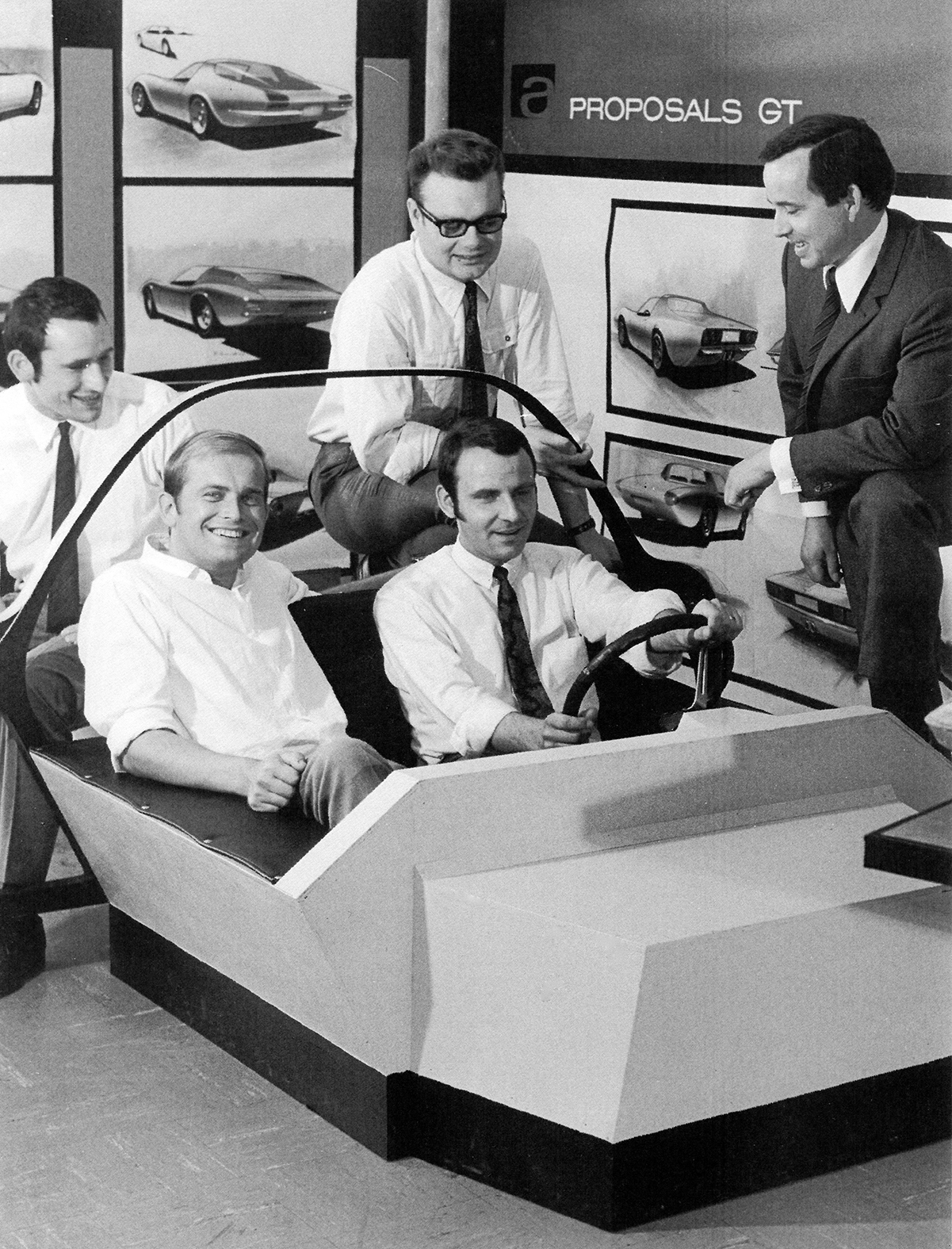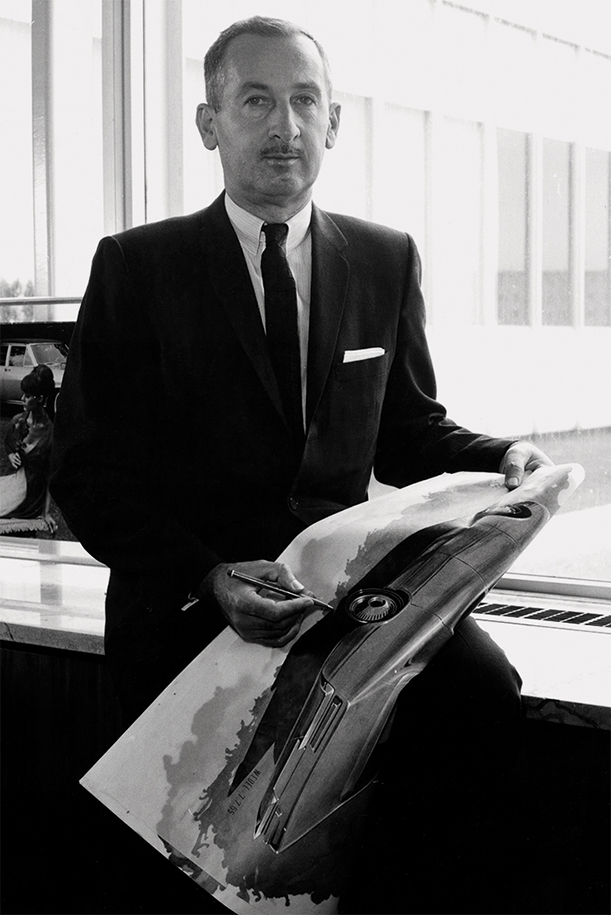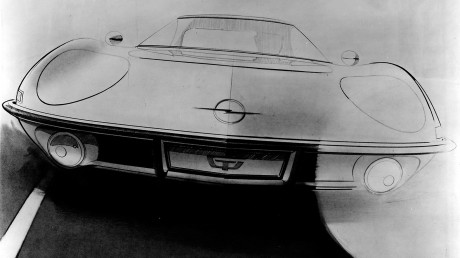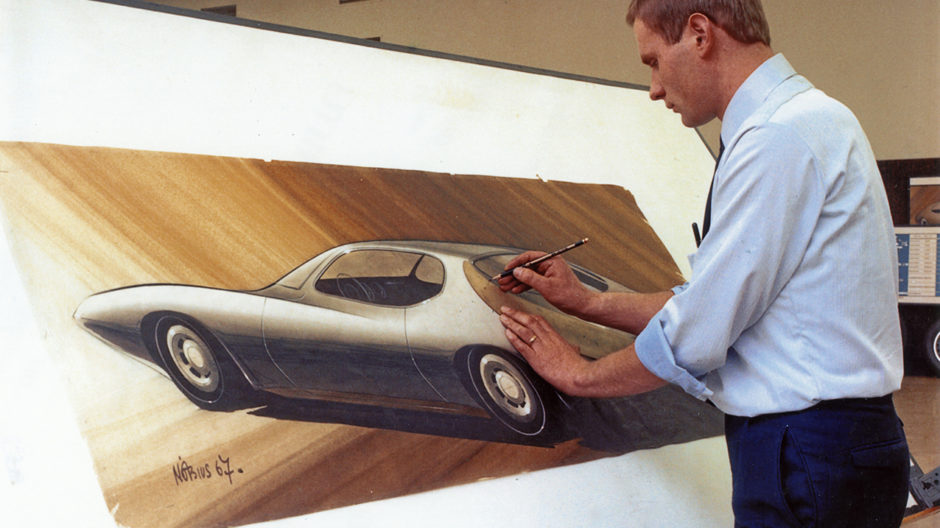- In den frühen 1960er Jahren war GM Styling die größte und leistungsstärkste automobile Designabteilung weltweit. 1956 nahmen die 1.200 Design-Beschäftigten in dem von Eero Saarinen entworfenen, komplett neuen Technical Center von GM in Warren bei Detroit ihre Arbeit auf. Von der Schlagkraft und den umfangreichen Fachkenntnissen GMs profitierte auch Opel entscheidend.
- Die neue Design-Organisation von Opel und die hochmodernen Design-Räumlichkeiten, die 1964 im Gebäude N10 eröffneten, nahmen direkte Anleihen am GM-Design in Detroit. Die neue Aufstellung hob die Opel-Kreativabteilung auf eine völlig andere Ebene und machte die Marke zum führenden Wettbewerber in Sachen Automobildesign in Europa.
- Clare M. MacKichan, der Gründer der Opel-Designabteilung in Rüsselsheim, sitzt bei einer der ersten Zusammenkünfte im neuen Gebäude inmitten seiner engsten Mitarbeiter. Gemeinsam machten sie Opel-Design zur modernsten und leistungsfähigsten Design-Organisation in Europa.
- Eine „Kult“-Skizze des Opel Experimental GT vom damaligen Leiter des Opel-Zukunftsdesigns, Erhard Schnell. Die Abteilung war konkurrenzlos in der europäischen Automobilindustrie und nahm ihre Arbeit mit dem 1965 auf der Frankfurter IAA präsentierten Experimental GT auf – einem außergewöhnlichen Sportwagen, den man sich leisten konnte.
- Zu seiner Premiere auf der Frankfurter IAA 1965 war der Opel Experimental GT das erste Konzeptfahrzeug seiner Art in Europa; kein anderer Hersteller hatte diese typische GM-Idee bis dato nach Europa geholt. Der Experimental GT zeichnet sich durch das „Coke-bottle“-Design von MacKichan aus: eine lange Nase, geschwungene Flügel und eine keilförmiger Taille.
- Nach dem umwerfenden Erfolg des Experimental GT auf der IAA in Frankfurt, entschied sich Opel, aus der Studie ein Serienmodell zu machen. Während die Ingenieure Chassis und Antrieb für den zukünftigen Opel GT entwickelten, brachten es die Designer mit neuen Zeichnungen und Tonmodellen in die richtige Form.
- In kürzester Entwicklungszeit wurde aus dem Experimental GT der Serien-GT. Namhafte Personen waren an der Validierung des Modells beteiligt, darunter Opel-Sales- und Marketing-Chef Bob Lutz (2. v. r.) genauso wie der VIP-Berater und fünfmalige Formel 1-Weltmeister Juan Manuel Fangio (2. v. l.).
- Elegante, kühne und farbenfrohe Opel- Entwürfe der 60er und 70er Jahre. Seinerzeit standen die Designer noch vor großen Staffeleien, um ihre Skizzen zu Papier zu bringen – hier am Beispiel von Wolfgang Möbius.
- Der Opel GT ging 1968 in Produktion. Doch die Opel-Designer wollten mehr: Das Advanced Design-Team unter Erhard Schnell (hier im Gespräch mit Hans Seer) schlug eine Aero GT-Version mit Targa- Dach vor, hier zu sehen als Tonmodell für die IAA 1969.
1964 was a year of Olympic Games – the XI Winter Games were opened in Innsbruck, and just a few months later, the Olympic flame burned at the XVIII Summer Games in Tokyo. And Rüsselsheim also extended an invitation to a special celebration. For the first time, guests were able to visit the new Opel Design Studio in building N10. For many of them it was also the last time, because after the grand opening, the futuristic-looking facilities were again closed to the public. From June 1964, forms, colors and functions of the brand’s cars were developed and decided here. “It’s easier to get into Fort Knox than into N10,” said an insider back then.

Opel’s design team led by Erhard Schnell (standing right) try out the future Opel GT’s interior at Opel’s brand new Advanced Studio.
The formal opening of the building marked a milestone in European automotive history. It was the largest design studio owned by an automaker in Europe. Up until then, most European car manufacturers often commissioned external specialists for the development of new concept cars. Northern Italy, in particular the area around the capital of the Piedmont region, Turin, was regarded as the mecca of automobile design. Pietro Frua, Guiseppe “Nuccio” Bertone and Pininfarina had all set up their coachbuilding enterprises between the Alps and the Apennines. They were responsible for the design of many of the car manufacturers’ new models and concepts.
The idea for Opel’s own design studio came from US parent company GM. In Warren, Michigan, near company headquarters in Detroit, GM Styling had already been working on the future of the automobile since the late 1950s. The first attention-getting concept car had been presented even earlier: after the Art & Color Section established in 1927 and headed by Harley Earl was re-named GM Styling in 1937, just one year later GM presented the Buick Y-Job – the first genuine concept vehicle in automotive history. The goal had been to develop a new, large convertible for the Buick brand to present to the public. The building in Warren was now built on the Rüsselsheim premises, identical in form, layout and function, just on a smaller scale.

In the early 1960s, GM decided to upgrade its European design capabilities and appointed a Chief Stylist to Opel for the first time. Clare M. MacKichan came from Chevrolet and led Opel Styling from 1962 to 1967, transferring the best of GM’s know-how to Germany and revolutionizing automotive design in Europe.
However, the Rüsselsheim design studio’s task was much more complex. It was to develop not only the design language of new model lines, but its sharp minds and visionaries were to reach out beyond the confines of daily business and research the design of future vehicles. Design was seen as strategic focus for future success, not as an end in itself. And this is exactly what made the difference. While others at best developed the shape of a new body, in Rüsselsheim thought was being put into design language and emotions, including aspects like what kind of statement, what character does the customer expect from the car of the future.
Advanced Studio was a department in N10, free from daily design work, charged not with working on what should be on the road tomorrow or the day after, but with developing possibilities and opportunities for products that would win over customers years down the road. This was a real challenge. Because as a designer back then said, if you are a step ahead of the mainstream’s taste, you are moving around on the precipice to boredom. Take a brave step further, and you have made yourself inaccessible to most people. Or to put it more bluntly: had someone entered the king’s palace in the 19th century with a tablet PC, that person would have had to reckon with being thrown in jail for subversive behavior. Maybe that is why some automobile studies look boring and uninspired just a few years after their premiere.

An iconic sketch of the Opel Experimental GT by Erhard Schnell, who led Opel’s Advanced Studio.
The Opel design studio’s task made it unique in Europe. It quickly turned into a European school for automobile design that had a magical attraction for the best in the industry. The studio’s personnel list from the past reads like a Who’s Who of the automotive design world: Anatole Lapine, Erhard Schnell, George Gallion, Charles M. ‘Chuck’ Jordan, Herbert Killmer, Chris Bangle, Murat Nasr and Hideo Kodama. And more than a few made their way to other manufacturers during their career after other brands had also established their own design studios years later. Many ideas, forms and design statements in automobiles originated in Rüsselsheim and reach back into the 1960s.
The list of design icons created by the Opel Advanced Design Studio in these 50 years can hardly be topped in its diversity. The Opel Experimental GT was the first masterpiece of work the young, committed team presented just one year after the new design studio was opened. The bold sports car already made its debut in 1965 at the Frankfurt Motor Show (IAA). Thereafter in quick succession followed the Opel CD, a streamlined coupé with a V8 engine in 1969, the GT2 with sliding doors in 1975 and the extremely aerodynamically optimized Tech1, whose drag coefficient of Cd 0.235 was an absolute sensation in the early 1980s. The women and men from the Advanced Design Studio team presented their latest work at the last IAA in Frankfurt. The Opel Monza Concept shows design solutions and technical approaches that will appear in the brand’s model lines in the coming years.
Shortly after Opel Styling was founded, designer Anatole Lapine put Opel in the limelight on the motorsport stage. He created the company’s first post-war racing car and as had previously been done with the Experimental GT, work was conducted without a mandate from company management. The racing car they created was based on the Opel Rekord C.
In combination with its considerable performance potential, the car’s black paintwork contributed to its legendary nickname. Spectators soon dubbed this high-speed Opel the “Black Widow”, after the most dangerous spider in the world. Piloted by Erich Bitter and a young Niki Lauda, the car entered a string of races between 1967 and 1969, its 180 hp, four-cylinder engine repeatedly leaving competitors well behind. Just how confident its drivers were in the face of ridicule is also demonstrated by their reaction to the derisive use of the word “Taxi” in describing their car. At that time, taxis were all painted in uniform black, so at the next race the car carried a yellow taxi sign on its roof.
Unfortunately, all traces of the unique vehicle were lost in the 1970s. But when a Rekord C manufactured in exactly the same year as the Black Widow turned up, the Opel Classic Workshop bought this rare specimen and converted it to a racing car with the exact specifications as Anatole Lapine’s original concept. The old master himself was on hand to help Opel Classic expert Jens Cooper wherever records were missing. When Cooper visited him in his retirement home in Baden- Baden, Lapine sketched the design of the rear axle on a menu from “Meals on Wheels”.









